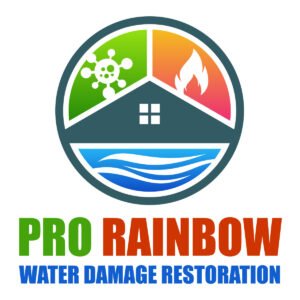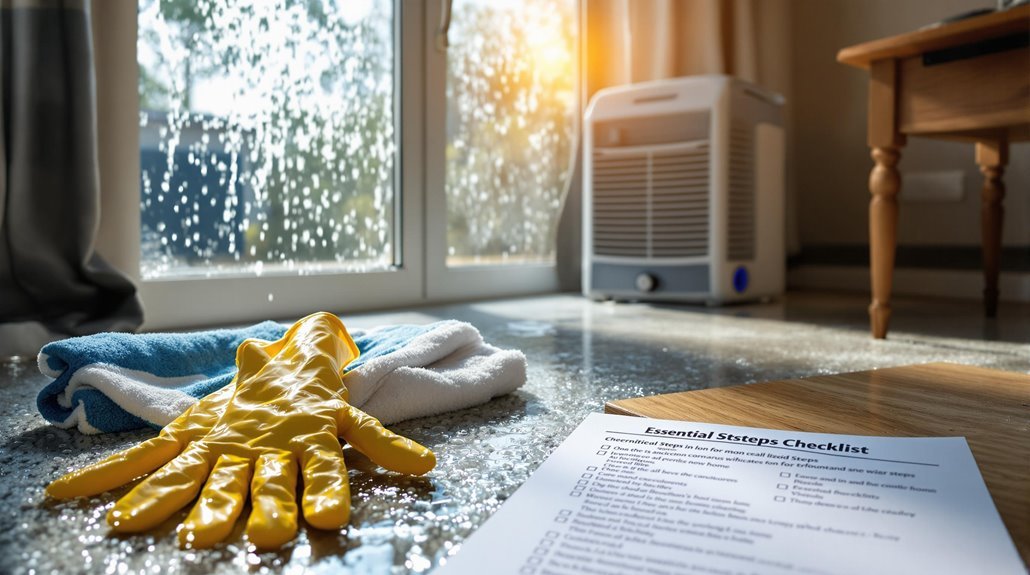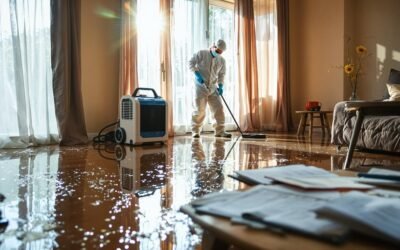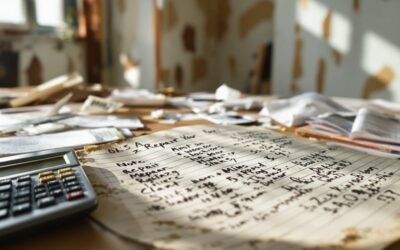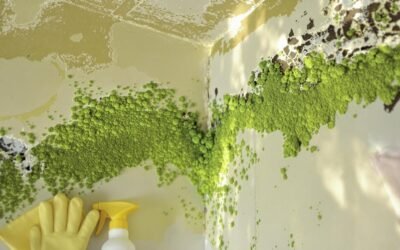After water damage, you need to act fast to minimize risks. Start by ensuring your safety—shut off electricity and gas, and wear protective gear. Identify and stop the water source, then use a wet/dry vacuum to remove standing water. Document the damage with detailed photos for your insurance claim. Dry affected areas with fans and dehumidifiers, and check for mold, taking care to contain it if found. Salvage important items and contact your insurance provider to report the incident. Finally, consider hiring water damage professionals for thorough restoration. Keep going to uncover each step in detail.
Key Takeaways
- Ensure safety by shutting off electricity and gas, and wearing protective gear before assessing the situation.
- Identify and stop the water flow by locating the source and turning off the emergency shutoff valve.
- Remove standing water using a wet/dry vacuum or sump pump, and clean up residual moisture promptly.
- Dry affected areas with fans and dehumidifiers, ensuring items are dried within 48 hours to prevent further damage.
- Document all damage with photographs and a detailed list for insurance claims and consult professionals for restoration if necessary.
Ensure Safety First
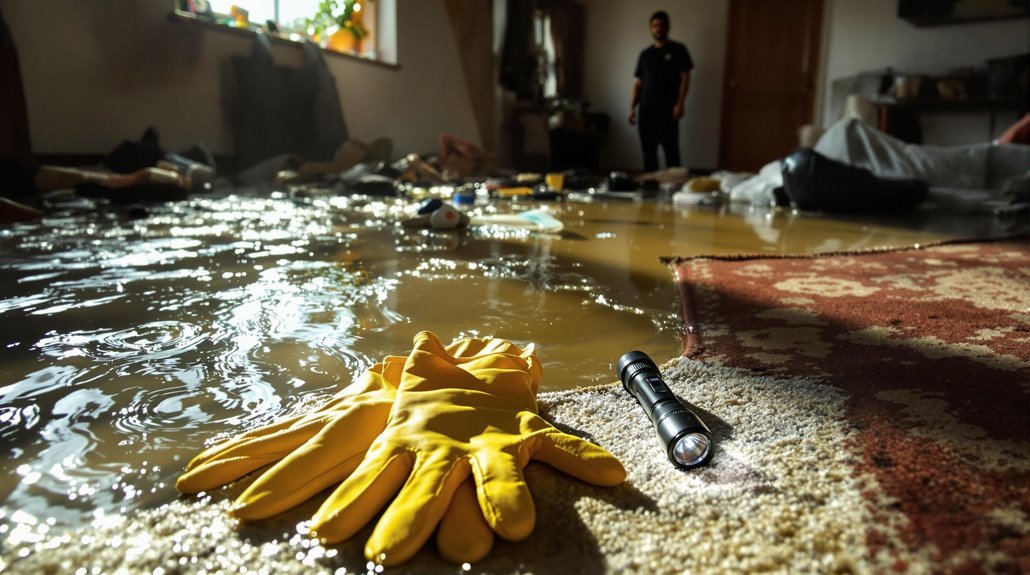
Before you assess the damage, guarantee your safety and that of others in the vicinity. Start by implementing vital safety precautions. If the water is from a contaminated source, avoid contact and evacuate the area. Shut off electricity and gas if you suspect any hazards. Wear protective gear, such as gloves and boots, to minimize exposure to harmful substances. After ensuring a safe environment, check your emergency kit. It should contain items like first-aid supplies, flashlights, batteries, and bottled water. Familiarize yourself with its contents beforehand so you can act quickly when needed. Remember, prioritizing safety is imperative before tackling any damage assessment or cleanup efforts. Your well-being and that of others must always come first. Additionally, it's crucial to call in trained professionals who can assist with the safe removal and restoration process.
Identify the Source
To effectively address water damage, you must first identify the source of the leak. Start by locating the specific area where water is entering your space, whether it's from a burst pipe, roof leak, or appliance failure. Once you've pinpointed the leak, assess the water source to determine the necessary steps for remediation. It's also crucial to conduct a detailed inspection and assessment of the damage to understand the extent of the problem.
Locate the Leak
Since a timely response is crucial, identifying the source of the leak should be your first priority after experiencing water damage. Start with thorough leak detection; inspect areas like pipes, fixtures, and appliances for visible signs of moisture or damage. Use your senses—listen for dripping sounds and feel for dampness. If necessary, conduct a plumbing inspection to pinpoint hidden leaks that may not be immediately apparent. Check your walls, ceilings, and floors for discoloration or warping, as these can indicate water intrusion. Once you've identified the leak's source, you can take the next steps in your recovery process. Prompt action will minimize damage and help prevent mold growth, ensuring your home remains safe and structurally sound.
Assess Water Source
While you've located the leak, evaluating the water source is crucial for effective remediation. Start with water source identification to determine whether the leak stems from a broken pipe, faulty appliance, or natural intrusion. Conduct a thorough plumbing inspection, checking all visible pipes and connections for signs of damage. Look for water stains, corrosion, or mold growth, as these clues can help pinpoint the problem's origin. If necessary, turn off the water supply to prevent further damage while you investigate. Once you've identified the source, document your findings for insurance purposes and inform a professional plumber if repairs are needed. Addressing the water source promptly can prevent extensive damage and costly repairs down the line.
Stop the Water Flow
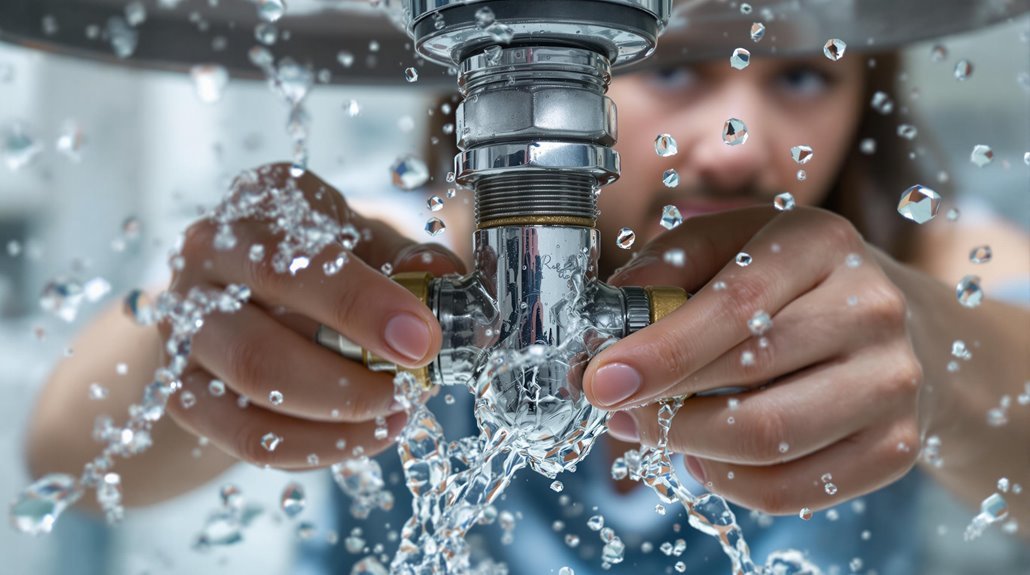
When you encounter water damage, the first critical step is to stop the water flow immediately. Locate the source of the leak and assess whether it's from a burst pipe, appliance malfunction, or another origin. For plumbing issues, find the emergency shutoff valve, typically located near your water meter or where the main line enters your home. Turn this valve clockwise to halt the water supply. If the leak is from an appliance, unplug it and turn off the specific valve connected to it. Implementing water flow prevention measures, like checking hoses and seals regularly, can help avert future incidents. Acting swiftly to stop the water flow minimizes damage and sets the stage for effective remediation.
Document the Damage
After stopping the water flow, it's vital to document the damage thoroughly. Start by taking clear photographs of affected areas and damaged items to provide a visual record. Next, create a detailed list of all damaged possessions, as this information will be necessary for insurance claims and restoration efforts.
Take Photographs Immediately
Taking photographs immediately is crucial for documenting water damage, as this visual evidence can be important for insurance claims and restoration efforts. By capturing the extent of the damage, you provide critical information for the damage assessment process.
| Action | Description | Why It Matters |
|---|---|---|
| Capture the Scene | Take wide shots of the affected areas. | Provides context for the damage. |
| Focus on Details | Zoom in on specific damage points. | Highlights severity and specifics. |
| Record Date/Time | Note when the photos were taken. | Establishes timeline for claims. |
| Store Safely | Back up photos to a cloud service. | Guarantees evidence isn't lost. |
These steps help you create a thorough record, making your case stronger when dealing with insurers.
Record Damaged Items
Recording damaged items is an essential step in the aftermath of water damage, as it guarantees you have a thorough inventory for insurance claims and restoration efforts. Start by creating an inventory checklist that lists each damaged item, including descriptions, quantities, and locations. Be specific about the damage to each item, as this will aid in item valuation. Take photographs or videos to visually document the extent of the damage, which can support your claims process. If possible, include receipts or proof of purchase for higher-value items. This detailed record will not only assist in filing claims but will also help you and restoration professionals prioritize repairs and replacements. Prompt documentation guarantees you don't miss any vital details.
Remove Standing Water
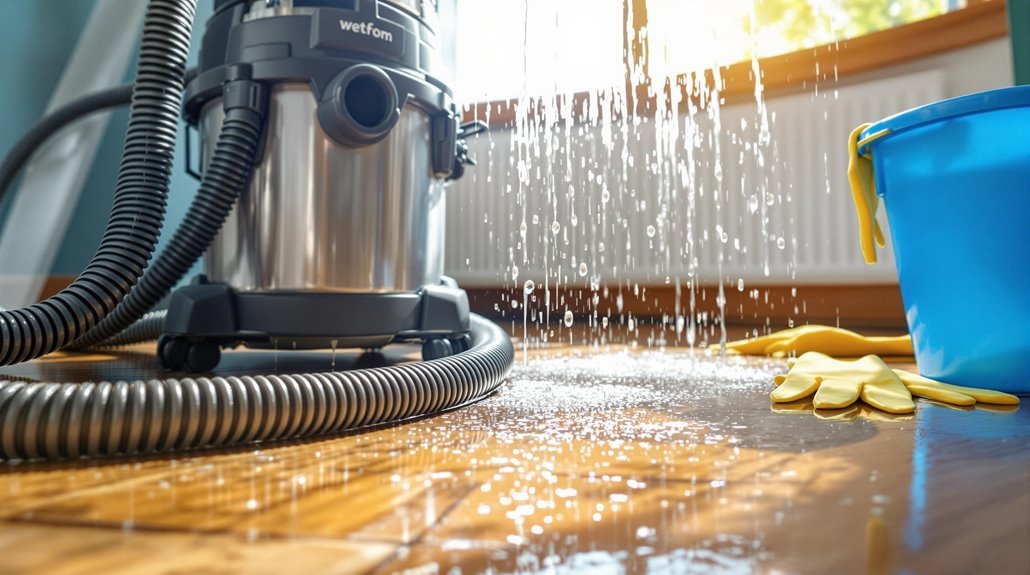
Start by removing standing water as quickly as possible to prevent further damage and mold growth. You can use a wet/dry vacuum for effective water extraction, ensuring you tackle all affected areas. While you're at it, conduct a thorough damage assessment to identify the extent of the water intrusion.
| Tools for Water Removal | Purpose |
|---|---|
| Wet/Dry Vacuum | Extracts standing water |
| Sump Pump | Removes large volumes of water |
| Mops and Towels | Cleans up residual moisture |
Once you've extracted the water, monitor the area closely. Quick action is essential to minimize secondary damage and safeguard your property.
Dry Affected Areas
After removing standing water, it's essential to assess the severity of the damage in affected areas. Use fans and dehumidifiers to promote airflow and expedite drying, ensuring no moisture lingers. Promptly remove any wet materials to prevent mold growth and further structural issues.
Assess Water Damage Severity
As you begin to address water damage, it's crucial to assess the severity of the situation by identifying the affected areas. Start your water damage assessment by checking walls, floors, and ceilings for signs of moisture, discoloration, or warping. Pay attention to hidden spaces like behind appliances or within cabinets, as these can harbor significant damage. Conduct a severity evaluation by determining the extent of saturation; this will guide your next steps in remediation. Use a moisture meter, if available, to quantify water levels accurately. Document your findings with photos and notes, which will be useful for insurance claims. Understanding the severity of the water damage helps prioritize your response and guarantees effective recovery efforts.
Use Fans and Dehumidifiers
To effectively dry affected areas after evaluating water damage, utilizing fans and dehumidifiers is essential. Start by strategically placing fans to maximize airflow; position them to blow air directly across wet surfaces. Confirm that the fan placement creates a cross-ventilation effect to improve moisture evaporation. Next, adjust your dehumidifier settings for peak performance. Set it to a low humidity level, typically between 30-50%, to efficiently extract moisture from the air. Check the dehumidifier's water reservoir frequently and empty it as needed. Both fans and dehumidifiers work synergistically to speed up the drying process, reducing the risk of mold growth and further damage. Monitor the affected areas regularly until they are completely dry.
Remove Wet Materials Promptly
Immediately removing wet materials is crucial in mitigating water damage and preventing mold growth. Start by identifying all affected areas and promptly dispose of any wet materials, such as carpets, drywall, and insulation. These items can harbor moisture retention, creating an ideal environment for mold proliferation. If possible, salvage any items that can be dried effectively, but prioritize the swift disposal of those that can't. Use appropriate wet material disposal methods to minimize health risks. For items that can be cleaned, confirm they're thoroughly dried within 48 hours to reduce moisture levels. Remember, the quicker you act to remove wet materials, the better your chances of preventing lasting damage and costly repairs.
Check for Mold
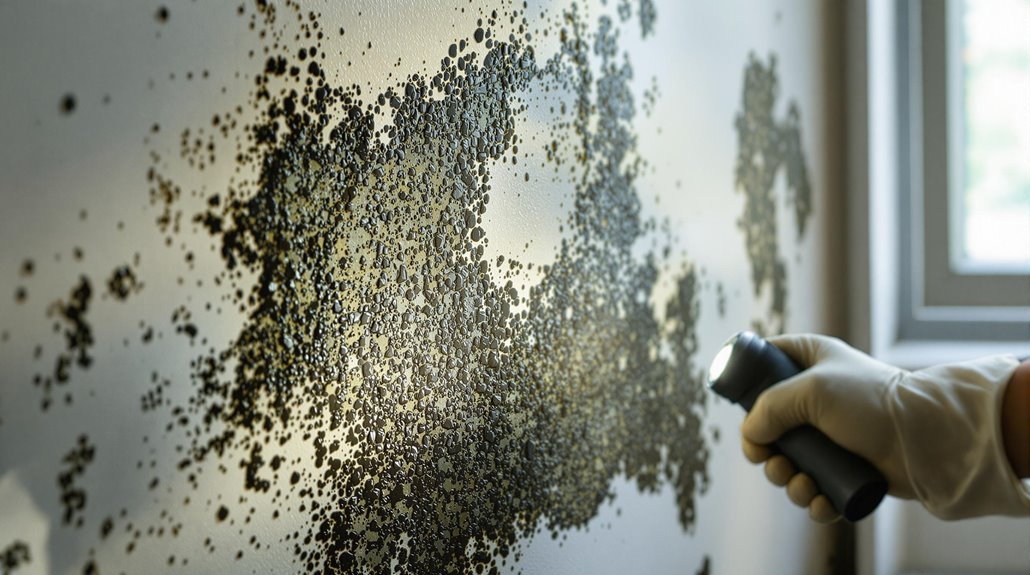
Since mold can begin to grow within 24 to 48 hours after water damage occurs, it's vital to check your property promptly. Start by conducting a thorough mold inspection of affected areas, including walls, floors, and hidden spaces like crawl spaces or behind furniture. Look for discoloration, musty odors, and visible growth. If you find mold, act quickly to contain it, as this is critical for mold prevention. Consider using protective gear, like masks and gloves, to avoid inhalation or skin contact. If the mold covers a large area, it may be wise to consult professionals who can safely remove it. Timely action can greatly reduce health risks and further damage to your property.
Salvage Important Items
When water damage strikes, salvaging important items should be your next priority, as quick action can often make the difference between recovery and total loss. Start by identifying critical items, such as important documents, financial records, and insurance papers. If they're wet, carefully separate them and dry them using a fan or a dehumidifier, avoiding direct sunlight which may cause further damage. For sentimental items like photographs or heirlooms, act swiftly but gently to minimize harm. If possible, freeze these items to halt deterioration until you can restore them properly. Remember, while material possessions can often be replaced, irreplaceable sentimental items and crucial documents require immediate attention to guarantee they're preserved for the future.
Contact Insurance Provider
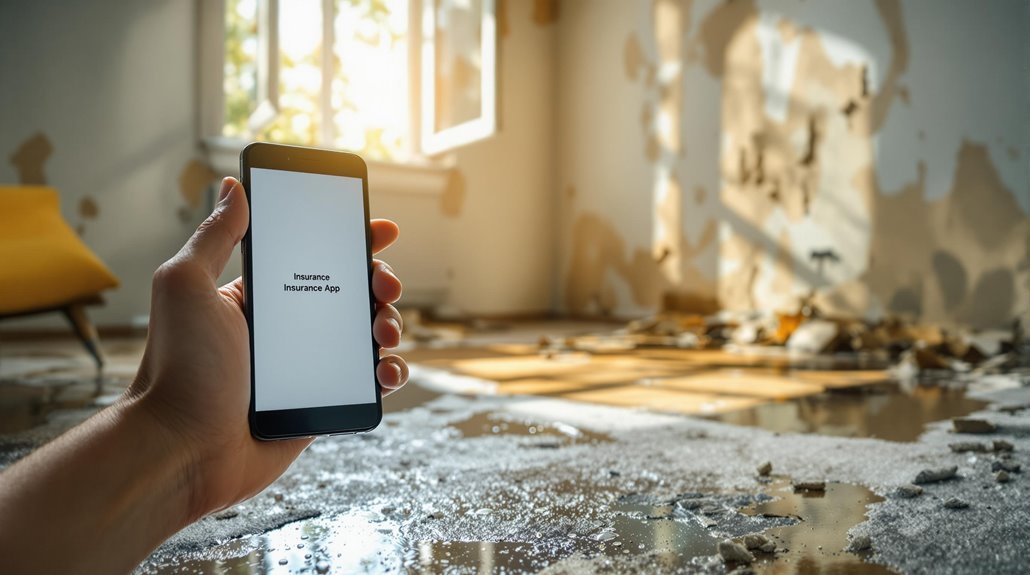
Contacting your insurance provider is crucial as soon as you've addressed immediate concerns after water damage. This step guarantees you understand your policy coverage and can initiate an insurance claim effectively. Here's what you should do:
- Document the Damage: Take clear photos and videos of affected areas and items.
- Review Your Policy: Familiarize yourself with the specifics of your coverage, including limits and exclusions.
- Report the Incident: Call your insurance provider promptly to report the damage and begin the claims process.
- Follow Up: Keep a record of all communications and any claim numbers for future reference.
Hire Water Damage Professionals
Hiring water damage professionals is essential to effectively restore your property and guarantee thorough remediation. These specialists possess the expertise and equipment necessary for extensive water damage restoration. They'll conduct a professional assessment to identify the extent of the damage and develop a tailored action plan. By utilizing advanced techniques, they can remove excess water, dry out affected areas, and prevent mold growth. Timely intervention reduces the risk of long-term structural damage and health hazards. Furthermore, professionals often work directly with your insurance provider, ensuring that your claims process is smooth and efficient. Don't underestimate the importance of their skills; engaging water damage experts is an investment in the safety and longevity of your property.
Conclusion
After water damage strikes, don't hesitate—act swiftly. By following these crucial steps, you can minimize further harm and guarantee a smoother recovery process. It's like using a trusty smartphone to navigate through a storm; the right tools and decisions make all the difference. Remember, your safety and the preservation of your belongings are top priorities. If you encounter overwhelming challenges, don't shy away from contacting professionals. They'll help you restore your space to its former glory.
